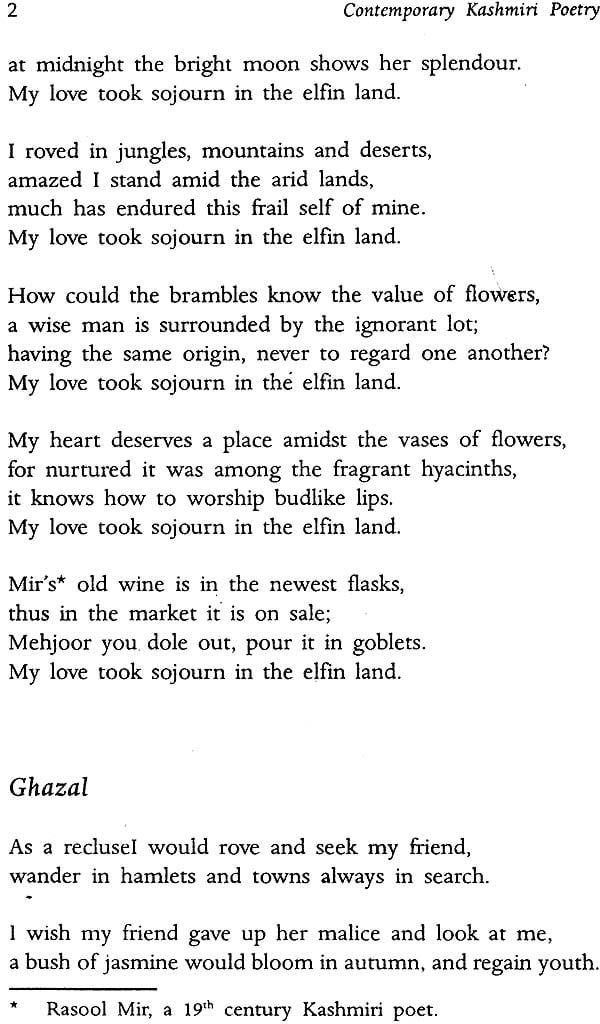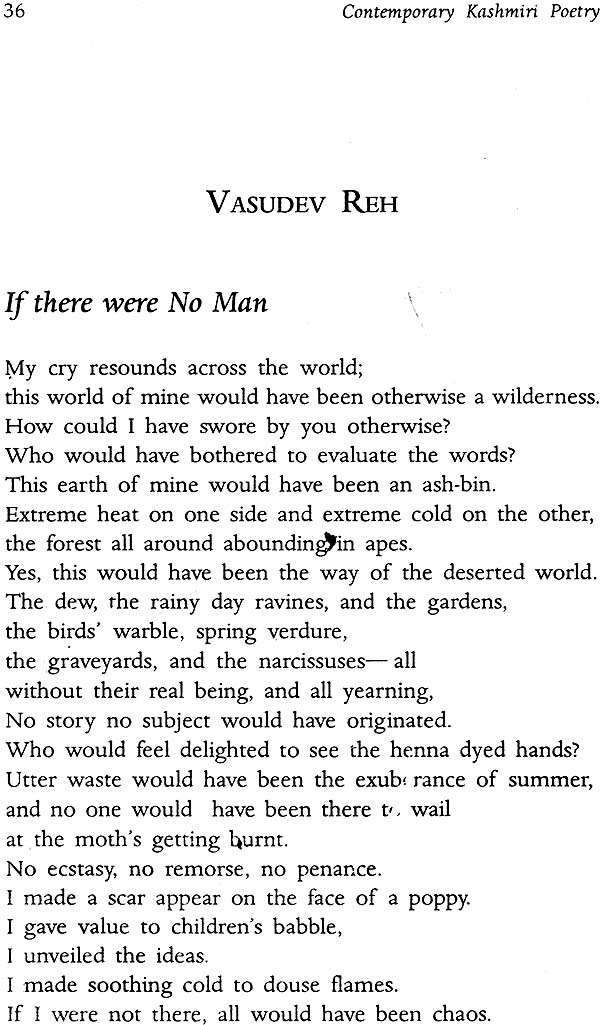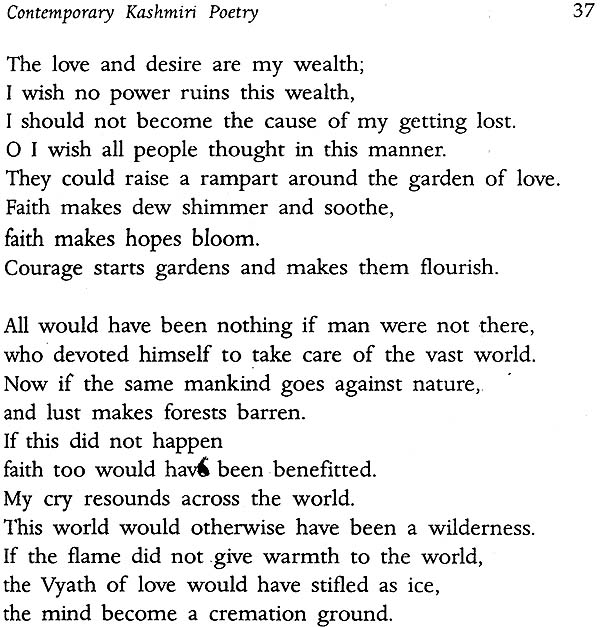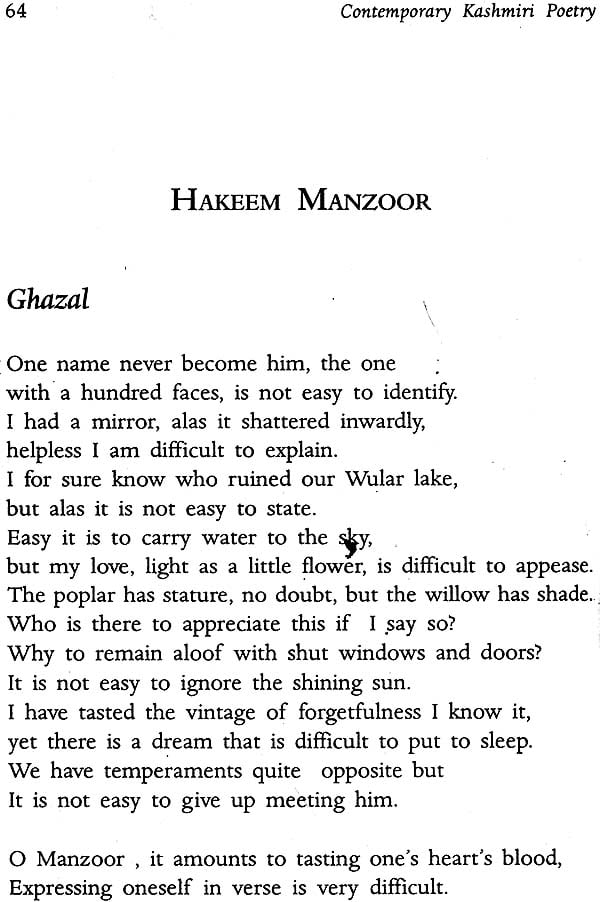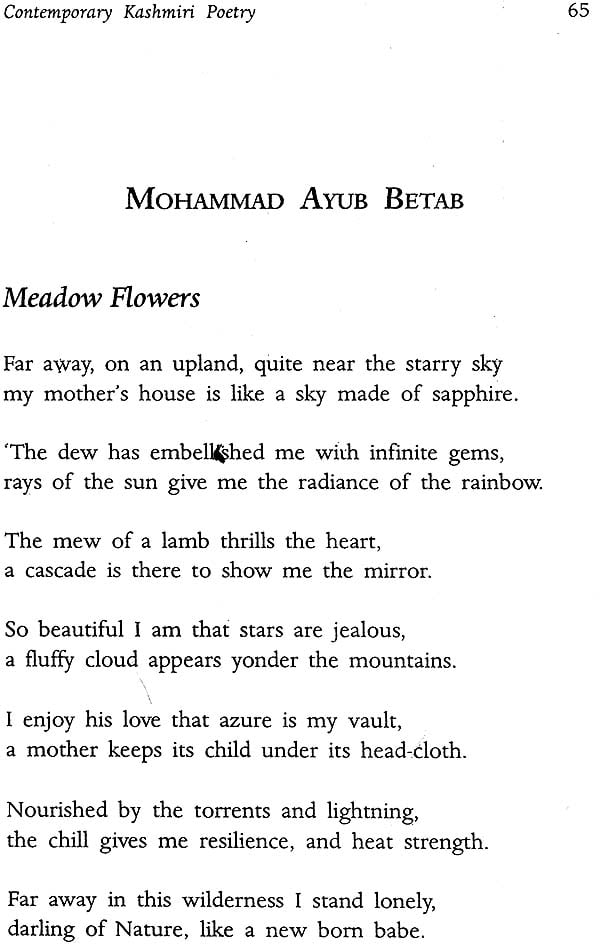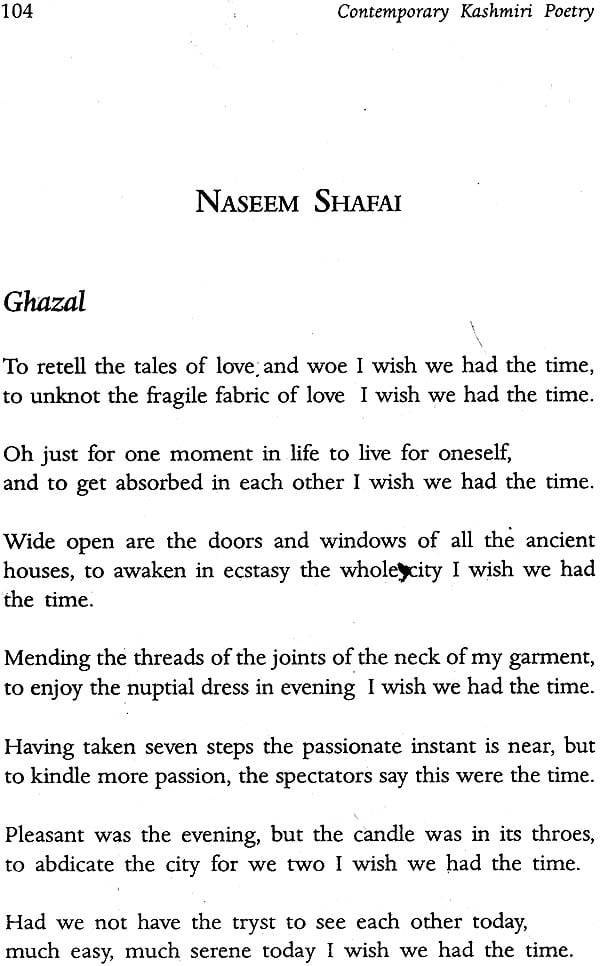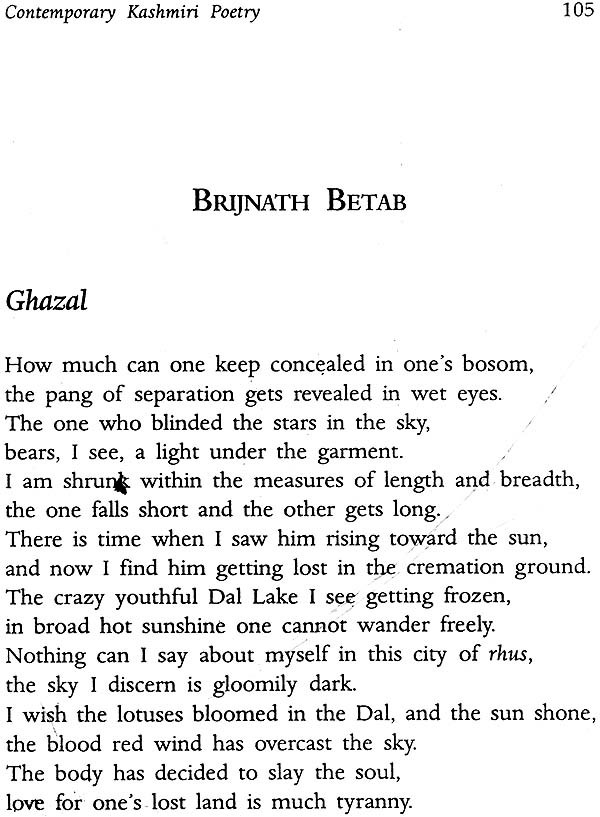
Contemporary Kashmiri Poetry: 1947-2010 (An Anthology of Post - Independence Indian Poetry in Kashmiri)
Book Specification
| Item Code: | NAK238 |
| Author: | Aziz Hajini and Shafi Shauq |
| Publisher: | SAHITYA AKADEMI, DELHI |
| Language: | English |
| Edition: | 2016 |
| ISBN: | 9788126051885 |
| Pages: | 147 |
| Cover: | Paperback |
| Other Details | 8.5 inch X 5.5 inch |
| Weight | 220 gm |
Book Description
Contemporary Kashmiri Poetry (1947-2010) comprises a selection of Kashmiri poems written in the period from 1947 to 2010. An attempt has been made to give proper space to all the literary trends, modes of perception, and styles of expression that emerged, developed and got strengthened in Kashmiri poetry during the period. It has been also the guiding motive of the compiler to give representation to all the representative poets lapses are however possible. It is important to note here that because of the prescribed limit of pages, it was not possible to include all the poets of the period.
Aziz Hajini: The compiler of the this anthology is a well-known researcher, critic, poet, playwright, and translator. He has been a fervent activist in organizing movement for the cause of the Kashmiri language. He worked in the Sheikh-ul-Alam Chair of the University of Kashmir for some years. He has also been Convener of the Advisory Board of Kashmiri in Sahitya Akademi and President of Adabi Markaz Kamraz. Presently he is Secretary, Jammu and Kashmir Academy of Art, Culture, and Languages.
Shafi Shauq is a poet, fiction writer, translator and linguist. He has published several books in Kashmiri, English, Hindi and Urdu. He has received several awards, including Sahitya Akademi Award in 2006 for Kashmiri.
After independence, a new era of poetry was ushered in, in India There were notable developments especially after 1950 when, after all the upheaval had died down, India began to craft her new visage. From them to now, several changes have occurred in both the themes and the form and style of poetry. This was the postcolonial era. There were several changes in the society, culture, history, politics and literature of the entire world. It also affected the poetry of every Indian language. There were several local changes in the culture, society and tradition of every language. That is the reason the Indian Sahitya Akademi decided, keeping the developments after 1050 in mind, to publish an anthology of poetry in every Indian languages, in which as many samples of verse be presented as possible. This is to reveal the craft of poetry as it has been brought out though its form in the poetry of every language.
Under this scheme, first an anthology of selected poems in every languages has been prepared in the original language, and, after that has begun the process of translation of these into other Indian languages. An attempt has been made to keep as close to the original language, yet even then it can be said with certainty that real enjoyment of the poem resides in the original language. But even so, it is possible to approach a particular kind of poem in a particular language through translation.
The literature of every language has a distinctive cultural aura. The unconscious is steeped in folklore or folk tradition. There are different roots for the development of every language. There is distinctiveness of phonetics, the hue of tradition; that is why it is now said that Indian literature is the conglomeration of literatures in many languages. In any case, Indian poetry does not simply mean monochromatic poetry. Indian poetry is like a bouquet, just like Indian literature; a palette with many colours. When we recognize 'diversity in unity' then we also recognize the glory of India The perception of the reality of multilinguality and a pluralist society is integral to this. Our national unity is also a part of this consciousness. In this way, poetry in different Indian languages will enrich our experience.
When we are face to face with India poetry of this era in many different languages, it also given rise to a critical faculty. This critical faculty operates among our own languages as well as with the poetry written in the other languages of the world that we read. We become aware of our own ability.
This can be stated with conviction that poetry in Indian languages is being written in a very powerful idiom and it should reach as many readers as possible all over the world. This series related to 'Indian Poetry' is an attempt to fill this gap. This series will a path to reach the poetry in every language and create a spontaneous interest in readers to know more about the poetry in every language and crate a spontaneous interest in readers to know more about the poetry in every language. This would be a mark of our success. After this, we will turn our attention in this series to the other literary genres of every languages.
The known history of the Kashmiri language is spread over more than seven hundred years. The two representatives of the earliest periods of our literature, namely Lalla Dyad and Sheikh-al Alam were contemporaries of the first poet of the English language, Chaucer. Various literary critics believe that the poetry of our poets is superior to that if Chaucer so far pure literary standards are concerned. The poetic traditions established by the two outstanding poets of the fourteenth and fifteenth centuries were continued by many other poets later ages like Habba Khatoon, Habibullah Nowshehri, Mehmood Gammi, Rasool Mir, Maqbool Shah Kralawari, Abdul Ahad Nadim, Wahab Parrey. Amir Shah Kriri and dozens of sufi poets. The result of this continuation of literature was that by the beginning of the twentieth century we had a rich repertoire of literature which has different colours and various modes. Well before the initial years of the twentieth century, the tradition of writing or translating epic and romantic mathnawis (versified narratives) was at its pinnacle and parallel to this tradition we had a firm and tremendously popular tradition of Sufi poetry. This mystic poetry was the means of entertainment, but at the same time, popular faith was associated with it. Traditions of Kashmiri poetry, noted above, remained dominant until 1931 when Mehjoor and Azad appeared on the scene with a new consciousness and an altogether different mode of expression.
Contemporary Kashmiri poetry in fact started soon after the change in social consciousness in 1931. The freedom struggle created a profound revolution and, eventually a fresh minds of our poets. The fact is incontrovertible that Mehjoor had started writing poetry in 1918, but his earlier poetry was not different from the sentimental poetry which was essentially effeminate both in terms of expression and emotional lamenting of love that had a long tradition spread over several centuries. Most of the poems composed by Mehjoor in the first ten years of his poetic career deal predominantly with the despondence and frigidity of emotions which had been common to all our Sufi and love poets. The songs of this nature included in the Collected Works of Mahjoor Make us think that if Mehjoor had continued writing in the same mode, it would have been sufficient to say about him that his poetry was nothing but an echo of Habba Khatoon, Maqqbool Shah Krlawari, Rasool Mir, Wahab Parrey and many other famous poets. But Mehjoor was clever enough to understand importance of being out of the rut, and as such he harmonized his poetry immediately with the political and social conditions of his time.. The fervent sentiment for freedom created such a tumult in Mehjoor's mind and it found spontaneous expression in his many verses:
Find material for the new world you have to found, belong to you in this new era, that is your era.
Give up wandering and take to rifle and machine gun, Rejuvenate your county, and leave your name behind.
Although verses like these are quite inferior in terms of artistic merit, not clear augured a new era of poetry which was fresh and novel in all respects. Since the conditions prevailing in Kashmiri at that point of time was suitable for this, Mehjoor won immediate popularity, and he felt encouraged. He, on the one hand, pondered seriously on the political conditions of Kashmir, he started reconsidering various nuances of Kashmiri poetry on the; as a corollary his poetry tended to assume symbolic colour. Till then he used to write fervent revolutionary and nationalistic lyrics like "Rise up O Kashmiri and exhibit you strength!" Then he adopted an indirect way of expression like: "O Poppy, O red poppy, express your heart!" which was a melodious and artistic way of expression. Calling Kashmir a garden and its people 'flower' was a new sensibility in which the use of the names of various health resorts, redolent meadows mellifluous birds and rumbling rivers was in such a way as heralded a new consciousness and admirable way of writing.
At Naseem garden I came to know
That you, bearing a bow are on hunting,
I, bearing my head shall rove
Who is to let the nightly owls live in the garden?
My falcon shall slay them with its claws.
The symbolic import of verses like these is evident, yet this oblique way of expression was visibly different from that of the Dufi poets. The symbols and images used by Mehjoor are known to every Kashmiri. This is the reason that the reader at least obtains the pleasure of surface meaning.
In spite of its excessive repetition of words and ideas, Mehjoor's poetry is admirable. The most significant quality of his poetry is that it stimulates consciousness of the tragedy of the tragedy of Kashmiri people, at the same time, while preserving the tradition, it establishes a new tradition. Not only this, he founded the way of writing poems with full consciousness about its form. It is a different story that the lyrical copiousness of the vatsan form dominated his poems and that it lacks the broadness of thought that we discover in Abdul Ahad Aza's poetry.
Azad, too, started his poetic career in a traditional way, but many harsh incidents in his life brought about transformation in his sensibility and eventually he became the first revolutionary poet in the language. Besides being well acquainted with the political development in the Russian Revolution of 1917, he was quite aware about the changing literary values of Urdu poetry; he, therefore, did not face many hurdles in founding a new intellectual approach and way of expression. He turned his back towards the conventional method of Kashmiri poetry and instead established revolting, energetic and angry style.
Religion, creed, country, state God,
God's power, destiny and fate, are used
As many other veils on truth
By the enemies of revolution.
The capitalists no more bear any moisture in their eyes
They act as day-time preachers, and teachers,
But nightly they behave as shroud-thieves.
It is therefore evident that by taking visible departure from all conventional principles, and beliefs, Azad wanted to establish a new world. He thought that patriotism, national fraternity and religious beliefs were the caprices of the capitalists, and persuade the workers and peasants to rise and bring a cataclysmic change in the old system. Thus Azad became indifferent to the aesthetics of poetry and preferred to become a representative of a particular ideology which became the of shallowness in his poetry. It, however, does not mean that Azad is an insignificant poet. Seeing the heights of his thought and vastness of his intellect, we cannot help appreciating his intellectual supremacy. Besides, he, for the first time presented to a Kashmiri reader a daring and self-conscious way of feeling. Although he borrowed this philosophical vision from Allama Iqbal, yet it was an intimate voice after the slavery of several hundred years and the death of Kashmiri consciousness.
Soaring of a crow, a bulbul, a parrot and a hawk is alike,
but see the difference between one flying and the other.
Fetters of slavery are better than that of love,
which make a youth standing erect lie prone.
Ideas like the ones that are expressed in such verses suited to the form of short poem rather than the ghazal; Azad appears to be stammering when he wrote in the ghazal, while many of his poems have an eternal significance. Poems like "shikwa-I Iblis" (The Complaint of Satan), shikwa-I Kashmir (Kashmir's Complaint) nala-I Badshah (Badshah's Lament) are still considered among the masterpieces in Kashmiri poetry, and his poem "daryaav" (River) is incontrovertibly an unparalleled piece of poetic composition:
I rumble through boulders, edgy rocks,
Abysses, chasms, whether it is day or night;
I need no bravos, nor am I interested in childish pranks;
What I am among the bats, the same I am among the bulbuls;
I find the rhythm of life
In travelling and newer destinations.
Intensity of emotions, flow and creative use of language, use of credible images, mellifluousness of music and the tome of soliloquy are some of the artistic qualities which are found abundantly in the poem. It appears that Aazad accomplished this literary achievement in the last phase of his life. The poem makes us believe in the fact that if death did not deprive the poet of his language, there would have been many more great poems like the one cited above. Side by side with Azad and Mehjoor, there were some more remarkable poets like Ghulam Nabi Ariz, Ghulam Nabi Dilsoz, and Abdul Satar Asi; but none of them could attain an individual position; on the contrary they continued to trudge the path shown by Mehjoor and Azad.
Azad died just seven and half months after independence, while Mehjoor passed away in 1952. The era was extremely important and crucial in our history. Achieving independence, partition of the subcontinent, aggression by the tribal people of the north-west, the agreement between Sheikh Moharnmad Abdullah and Jawaharlal Nehru on accession were some consequential events which became some favourite themes for the writers of the time and are still being written about. When there was no remarkable change in the economic and social conditions of the millions of poor people of India even after the establishment of democratic government, a widespread disillusionment overwhelmed all minds. On observing this depravity in every corner of the country, the sensitive minds felt a sort of emotional revulsion and a literary revolt started in all languages of the country. Mehjoor wrote an admirable poem, titled aazaedyi (Freedom), of the nature which castigates, in a pleasant way of course, the historical conditions of the time. In the meantime the Progressive Movement acquired overwhelming influence in the state like all the states of the country; the writers of Kashmir, too, gradually embraced the Movement and Cultural Congress came into existence. The Marxist point of view presented by Abdul Ahad Azad assumed the shape of a fervent movement. The literature, both prose and poetry, produced during the period, was written under a set formula and its thought- content was monotonous at every level. It was an emotional tide in which all the poets and writers participated with full vigour. Their association with the Movement resulted in subservience of poetry to one theory. Borrowed propaganda and hollow slogan-mongering became the hallmark of literature. The worker was presented as an angel and the affluent became the target of slander and condemnation: this was considered essential and fundamental literary merit of every piece of literature. A result of this approach was that poetry of the time became rhetoric and the variety of expression was curtailed. The poet had no choice but to sacrifice his individual thought for collective ideals and principles. All these trends resulted in the paucity of good poetry. The poets, on the contrary tried to present their uncontrolled sentimentalism in such words as were commonly understood and at the same time proved provoking and instigating. Every argument was supported by illustrations. Here are a few examples:
Why should wealth have respect and the wealthy rule?
Why should empty rattans bear thorns on their heads?
Why should one possess in excess and others crave?
All this I have to ask the arrogant capitalists?
All this I have to ask before the arriving spring.
(Nadim)
I am the producer, and the production is mine,
The earth is mine, the sky, and the world are mine;
It is clear that the flames in the sky are mine;
We have to establish a new order and a new era;
We have to architect new Man and a new world.
(Noor Mohammad Roshan)
First you see who to cut through rocks
and made rivers flow,
Then you may talk of Shalimars,
and flower gardens.
(Rahman Rahi)
Despite numerous faults, this poetry too has a historical significance. I agree to a large extent with the opinion of Ali Abmad Saroor:
This literature has little literary value. The sweetness of its rhythm fades soon. It has plenty of emotions, but no intellect; it has heat, but no light, it has the heart, but no brain. The ideas are limited, and information insufficient. Nevertheless, its truth and sincerity are admirable. * (What is Criticism, p. 144)
Our poets got benefitted by getting associated with the Movement for it provided them with the opportunity of doing and realizing something new. In order to make their voices more serious they studied various literary movements and poetic compositions available in other languages. This broadened their vision and when after some time they got sufficient acquaintance with real literature, they distanced themselves from slogan mongering and eventually the Progressive Movement, that had become a component of their faith, started waning and a new sensibility took its shape.
One important thing worth mentioning here is that during the fervent years of the Progressive Movement several Kashmiri poets continued giving expression to their religious, devotional and mystic ideas and romantic passions in their individual ways. It is a different story that none of these poets could overcome the clamour of the Progressive Movement. In short the poets of this category also remained engaged in embellishing the garments of Kashmiri poetry with the gems of their beautiful creative experiences; in spite of their being traditionalists, their contribution is commendable.
| Foreword by S.S. Noor | ix |
| Preface by Aziz Hajini | xi |
| Cghulam Ahmad Mehjoor | 1 |
| Abdul Ahad Aad | 4 |
| Master Zindah Koul | 6 |
| Samad Mir | 8 |
| Ghulam Rasool Kamgar | 10 |
| Ahad Zargar | 11 |
| Ghulam Rasool Nishat Kishtwari | 14 |
| Rasa Javidani | 15 |
| Ghulam Ahmad Fazil Kashmiri | 17 |
| Mirza Arif Beg | 19 |
| Ghulam Rasool Nazki | 22 |
| Janbaz Kishtawari | 23 |
| Tanha Ansari | 24 |
| Dinanath Nadim | 25 |
| Ghulam Nabi Firaq | 28 |
| Amin Kamil | 30 |
| Rahman Rahi | 32 |
| Shamboonath Bhat Haleem | 34 |
| Vasudev Reh | 36 |
| Mohi-ud Din Nawaz | 38 |
| Arjan Dev Majboor | 39 |
| Ghulam Nabi Khayal | 42 |
| Fariq Badgami | 43 |
| Ghulam Rasool Santosh | 43 |
| Fariq Badgami | 43 |
| Ghulam Rasool Santosh | 44 |
| Manzoor Hashmi | 45 |
| Nishat Ansari | 46 |
| Hamidi Kashmiri | 47 |
| Rashid Nazki | 48 |
| Naji Munawar | 49 |
| Ghulam Nabi Nazir | 50 |
| Ghulam Nabi Gauhar | 51 |
| Muzaffar Aazim | 52 |
| Moti Lal Saqi | 54 |
| Abdul Rahman Azad | 56 |
| Marghoob Banihali | 58 |
| Chaman Lal Chaman | 60 |
| Mohan Lal Ash | 61 |
| Mohi-ud Din Gauhar | 63 |
| Hakeem Manzoor | 64 |
| Mohammad Ayub Betab | 65 |
| Ghulam Mohammad Shad | 67 |
| Shahbaz Rajourvi | 68 |
| Farooq Nazki | 69 |
| Ali Mohammad Shahbaz | 70 |
| Makhan La! Kanwal | 72 |
| Bashir Bhaderwahi | 73 |
| Mishal Sultanpuri | 74 |
| Sayed Rasool Pompur | 75 |
| Mushtaq Kashmiri | 76 |
| Shahid Badgami | 77 |
| Zareef Ahmad Zareef | 78 |
| Mohammad Ahsan Ahsan | 80 |
| Sheikh Razi | 81 |
| Piare Hatash | 82 |
| Shafi Shaida | 83 |
| Bimla Raina | 84 |
| Premnath Shad | 86 |
| Ghulam Mohammad Ghamgeen | 87 |
| Manshoor Banihali | 88 |
| Ghulam Nabi Atash | 89 |
| Ayub Sabir | 91 |
| Ghulam Rasool Josh | 92 |
| Saidullah Saidi | 93 |
| Ranjoor Tilgami | 94 |
| Tanha Nizami | 95 |
| Fayaz Tilgami | 96 |
| M.H. Zaffar | 97 |
| Shafi Shauq | 98 |
| Ghulam Hassan Ghamgeen | 99 |
| Abdul Ghani Beg Athar | 100 |
| Mushtaq Faridi | 101 |
| Rafiq Raz | 102 |
| Ayaz Rasool Nazki | 103 |
| N aseem Shafai | 104 |
| Brijnath Betab | 105 |
| Mohammad Yousuf Mashoor | 106 |
| Ali Shaida | 107 |
| Bashir Arif | 108 |
| Bashar Bashir | 109 |
| Shad Rarnzan | 111 |
| Shahnaz Rashid | 112 |
| Rikshana Jabeen | 113 |
| Aziz Hajimi | 114 |
| Majrooh Rashid | 116 |
| Mehfooza | 118 |
| Shejzada Rafiq | 119 |
| Notes on Poets | 120 |

